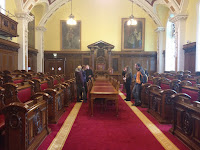St. George's Market
This market has many great booths depending on what day you go. I've only been on Saturdays, when they have more produce and food. I usually go about once every other week to get fruit for the next two weeks. I have yet to go on other days, but I have heard that Friday has more crafts and Sunday has useful items. I plan on going on one of these other days before the end of my time here, but for now, I just wanted you to know about it!
Here is the address for the market if you are interested in learning more:
Glens of Antrim
Carrickfergus Castle is a large castle built by the Norman
John de Courcy who overthrew the kings ruling the north of Ireland thus
establishing his prominent rule in the region. It was constructed in 1180 to
guard the approach to Belfast Lough. The history of the castle and its role in defense of this region of Ulster is provided through exhibits and audio-visual
facilities within the castle.
Carrick-a-Rede
bridge is a swinging rope bridge spanning an 800 feet wide chasm connecting the
main land to the Carrick-a-Rede island which is used by fishermen. The bridge
crossing is quite thrilling and not for the faint hearted! It is open between
the months of April and September.
Old Bushmills
Distillery is the oldest licensed distillery in the world where the renowned
Bushmills whiskey has been distilled legally since 1608 when King James 1
granted its license. A guided tour of the distillery is provided where the
secrets of whiskey production is revealed and the visitor also allowed to
sample the distilled product.
Dunlace Castle was
built by Richard de Burgh, the Earl of Ulster. In 1584 it fell to the
famous battle hardy MacDonnell clan who ruled this north eastern corner of
Ireland in the 16th century. In 1588 the MacDonnells used their helping
of the treasures from the Spanish Armada ship the Girona, wrecked off the
Giant's Causeway, to refurbish the castle. However, in 1639, during a
violent storm, part of the castle fell into the sea after which it was abandoned
by the MacDonnells. It has a breathtaking location perched on a cliff top
along the spectacular county Antrim coast.
Game of Thrones
Game of Thrones is a
popular and fairly new series--soon start it's second season--filmed by HBO.
A majority of the series is filmed in Northern Ireland. Throughout
my time in Belfast, I've met some of the extras that work on set. On our
tour of the Glens of Antrim, we saw several of the sights used during filming.
Unfortunately I was not able to get a great picture of the prop castle
that was built/being built. However, I was able to capture an image of
the Wall. If you've read the books or seen the show, you know how lacking
this little white painted portion of stone is to the actual Wall, but with
special effects and proper camera angles, you can use your imagination to see
how this little bit would be used to portray the Wall. Also
below, I have a description of the show for all those who have not
read the books or seen the show.
A Description of the Show
"Summers span
decades. Winters can last a lifetime. And the struggle for the Iron Throne has
begun.
"It will
stretch from the south, where heat breeds plots, lusts and intrigues; to the
vast and savage eastern lands; all the way to the frozen north, where an
800-foot wall of ice protects the kingdom from the dark forces that lie beyond.
Kings and queens, knights and renegades, liars, lords and honest men...all will
play the 'Game of Thrones.'
"A new original
series based on George R.R. Martin's best-selling 'A Song of Ice and Fire'
series. Winter is coming soon to HBO."
The Wall
Sources:
History of Glens of Antrim sites: http://www.guide-to-nireland.com/antguide.htm#Antrim
Game of Thrones information: http://www.hbo.com/#/game-of-thrones/about/index.html



















